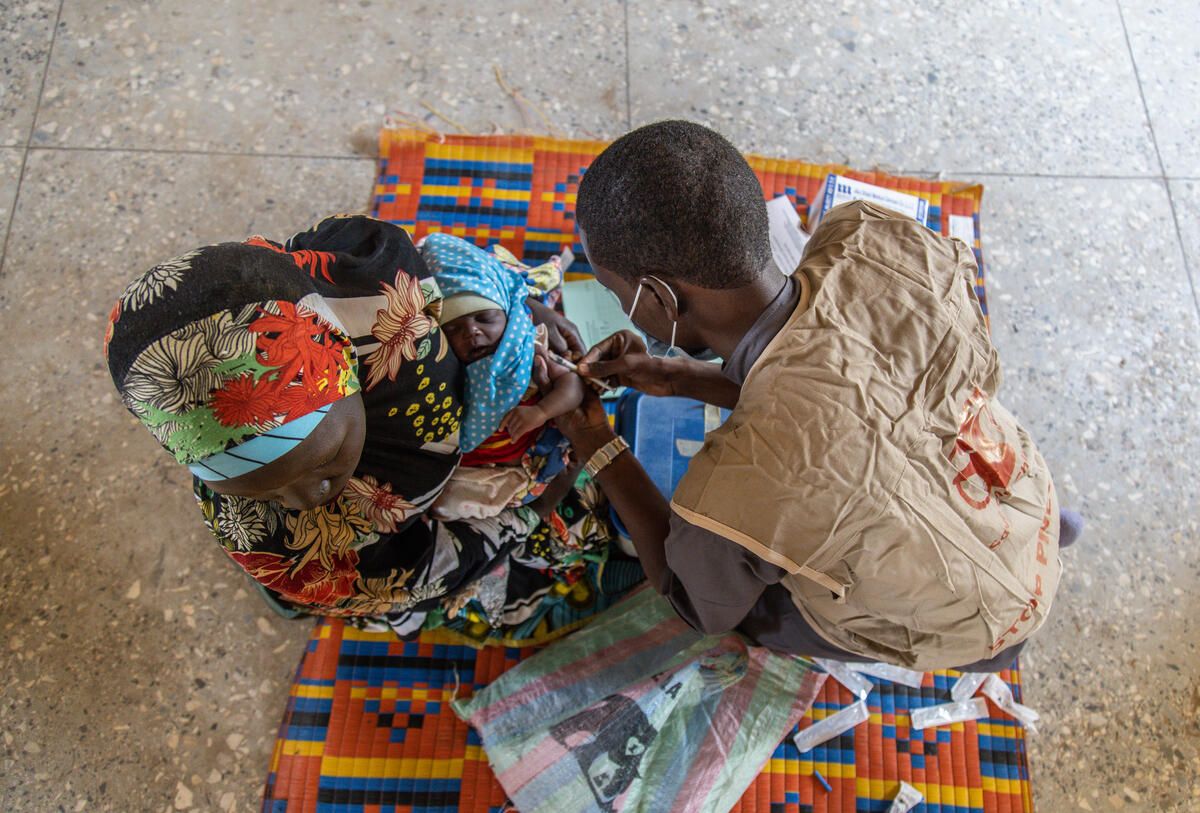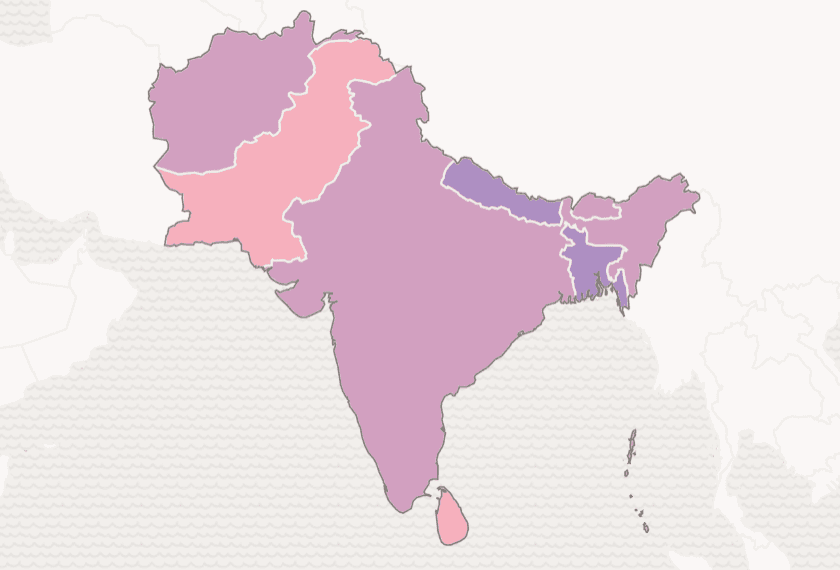
Saving children with vaccines
Globally, vaccines are one of the main drivers behind the decline in child mortality over the past 30 years. Vaccine coverage has improved greatly over the past decades: a graph from the Child Atlas below shows trends in data on the percentage of infants who received three doses of diphtheria, pertussis, and tetanus vaccine (DPT3), a crucial vaccine in childhood immunisation, from 1980 to 2022 . The global percentage of infants receiving three doses of the DTP3 vaccine increased from 20% to 84% compared to an increase from 1% to 69% in West and Central Africa. The trend lines show a considerable gap in the progress between children in the rest of the world and children in West and Central Africa. However, the steady increase in vaccination rates is threatened by several factors: for instance, the COVID-19 pandemic led to the suspension of several immunisation campaigns.
 The Child Atlas also depicts the most recent data on the same in global, regional, and national maps. Let's look at the one on West and Central Africa below. The map shows that DPT3 vaccine coverage differs widely among neighbouring countries in the region, from 99% in Ghana, to 60% in Gabon, to less than half the population in Guinea (47%) and Central African Republic (42%). This shows that the regional average conceals the varying rates of vaccine coverage in countries across the region which provide interesting insights.
The Child Atlas also depicts the most recent data on the same in global, regional, and national maps. Let's look at the one on West and Central Africa below. The map shows that DPT3 vaccine coverage differs widely among neighbouring countries in the region, from 99% in Ghana, to 60% in Gabon, to less than half the population in Guinea (47%) and Central African Republic (42%). This shows that the regional average conceals the varying rates of vaccine coverage in countries across the region which provide interesting insights.
 The Child Atlas also allows us to look into the trends of individual nations within the region. For instance, looking into the change over time in Ghana, Guinea, and Equatorial Guinea as shown below, we see a nuanced picture of progress and stagnation. Ghana's rise from the bottom in 1980 through a steady increase to achieving nearly full coverage in 2022 is exemplary for other countries in the region. It shows that with the right support, policy and investment, any country from any part of the world can deliver on crucial child rights, such as vaccination. In contrast, we see Equatorial Guinea's rollercoaster journey with a noticeable sharp rise in the mid-1980s, followed by a sharp fall in the late 1990s. After some more up and down, from 2010 onwards, there has been no observable progress in vaccine coverage from around 50%. Guinea experienced a surge in child vaccinations in the early 1990s but in later years, it failed to maintain the momentum of its progress. Regrettably, from 2010 onwards, there was a fall in the share of infants who received the DTP3 vaccine in Guinea. Since then, progress has been flat, and it has the lowest coverage among the three countries. The DTP3 vaccines are three doses, and many children remain under-vaccinated, meaning that they do not complete all the three doses. Low first-dose (DPT1) coverage and high relative dropout before the third dose together drove low DPT3 coverage in Equatorial Guinea and Guinea. These are worrying trends and serves as a poignant reminder of the work that lies ahead.
The Child Atlas also allows us to look into the trends of individual nations within the region. For instance, looking into the change over time in Ghana, Guinea, and Equatorial Guinea as shown below, we see a nuanced picture of progress and stagnation. Ghana's rise from the bottom in 1980 through a steady increase to achieving nearly full coverage in 2022 is exemplary for other countries in the region. It shows that with the right support, policy and investment, any country from any part of the world can deliver on crucial child rights, such as vaccination. In contrast, we see Equatorial Guinea's rollercoaster journey with a noticeable sharp rise in the mid-1980s, followed by a sharp fall in the late 1990s. After some more up and down, from 2010 onwards, there has been no observable progress in vaccine coverage from around 50%. Guinea experienced a surge in child vaccinations in the early 1990s but in later years, it failed to maintain the momentum of its progress. Regrettably, from 2010 onwards, there was a fall in the share of infants who received the DTP3 vaccine in Guinea. Since then, progress has been flat, and it has the lowest coverage among the three countries. The DTP3 vaccines are three doses, and many children remain under-vaccinated, meaning that they do not complete all the three doses. Low first-dose (DPT1) coverage and high relative dropout before the third dose together drove low DPT3 coverage in Equatorial Guinea and Guinea. These are worrying trends and serves as a poignant reminder of the work that lies ahead.
 Investments in vaccinations have multiple returns to children as well as governments. The Sustainable Development Goal (SDG) target 3.8 calls for access to safe, effective, quality, and affordable vaccines for all. Increasing the coverage of child vaccinations is expected to have catalytic impacts on other SDG targets and indicators. For instance, if Equatorial Guinea and Guinea can vaccinate more children, it will be more likely for these countries to achieve the SDG target of under-five mortality. Moreover, the return on investment for immunization has been estimated to be US $44 for every dollar invested, including broader social and economic benefits. In West and Central Africa, concrete steps and concerted efforts of the global community and local stakeholders is needed to accomplish SDG 3.8 and change the trajectory of progress for countries like Guinea and Equatorial Guinea.
Investments in vaccinations have multiple returns to children as well as governments. The Sustainable Development Goal (SDG) target 3.8 calls for access to safe, effective, quality, and affordable vaccines for all. Increasing the coverage of child vaccinations is expected to have catalytic impacts on other SDG targets and indicators. For instance, if Equatorial Guinea and Guinea can vaccinate more children, it will be more likely for these countries to achieve the SDG target of under-five mortality. Moreover, the return on investment for immunization has been estimated to be US $44 for every dollar invested, including broader social and economic benefits. In West and Central Africa, concrete steps and concerted efforts of the global community and local stakeholders is needed to accomplish SDG 3.8 and change the trajectory of progress for countries like Guinea and Equatorial Guinea.
Low rates of child vaccinations in West and Central African countries elucidate the vulnerabilities of children living in these countries and underscore the necessity of improving vaccine delivery systems. On the supply side, local production of vaccines, wherever possible, will be conducive to effective mass vaccination needed to achieve universal coverage of all children in West and Central Africa. The G7 should prioritize investment and collaboration with emerging market manufacturers to boost manufacturing capacity in poorer countries. Donors that have committed a minimum of 0.7% of GNI on ODA should make serious efforts to meet this target with increased spending on health ODA. On the demand side, carefully designed public awareness campaigns must be continued through traditional methods, conventional media outlets, and social media to dispel myths about child vaccinations and encourage more people to get their children vaccinated. The global community together with local actors must strive for a world where no child will be left unvaccinated from life-threatening infectious diseases.
Related stories:
Related stories

How a Soap Opera Helped to Reduce Child Marriage
Child protection (CP)
Child protection (CP)
2025-12-09

Does Insurance Benefit Child Health? Lessons from 38 Countries
Health (HL)
2025-11-19